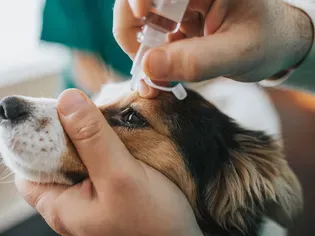Eye Drops For Dogs: Tips For Giving Your Dog Vital Medication
Updated on 05/26/24

Eye Drops for Dogs: A Comprehensive Guide to Administering Vital Medication
As a devoted dog owner, ensuring your furry companion's well-being is paramount. Eye drops are often prescribed for dogs suffering from a variety of ailments, but administering them can be a daunting task. This comprehensive guide will provide you with expert tips and techniques to help you give your dog vital eye medication with ease.
Understanding Eye Medications for Dogs
Before delving into the administration process, it's essential to understand various eye medications available for dogs.
* Antibiotics: Combat bacterial infections in the eye.
* Antivirals: Treat infections caused by viruses.
* Antifungals: Effective against fungal infections.
* Corticosteroids: Reduce inflammation and suppress immune responses.
* Artificial Tears: Lubricate dry eyes and provide relief from irritation.
Preparing for Eye Drop Administration
1. Gather Materials: Prepare eye drops, a clean gauze or cloth, and treats for your dog.
2. Position Your Dog: Gently restrain your dog's head and tilt it slightly back.
3. Comfort Your Dog: Keep your dog calm and relaxed by speaking soothingly and offering treats.
Administering Eye Drops
1. Create a Space: Gently pull down your dog's lower eyelid to create a small pocket.
2. Aim and Apply: Tilt the eye drop bottle and gently squeeze a single drop into the pocket.
3. Massage the Eye: Use a clean gauze or cloth to gently massage the eye for about 30 seconds, allowing the medication to penetrate.
4. Offer Treats: Reward your dog immediately after administering the eye drops to create a positive experience.
Tips for Dogs Who Resist
* Use a Towel: Wrap your dog in a towel to restrict their movement and make them feel secure.
* Get Help: Ask a friend or family member to assist in holding your dog while you administer the eye drops.
* Use a Restraint: In cases of extreme resistance, a dog muzzle or cone can be used to prevent your dog from biting.
* Practice: With patience and consistency, your dog will gradually become more comfortable with the process.
Examples of Eye Drop Administration in Practice
* Treating Bacterial Conjunctivitis: Dogs with bacterial conjunctivitis may require antibiotic eye drops. Use the technique described above to administer the drops into the affected eye.
* Managing Dry Eye Syndrome: Artificial tears can provide relief for dogs suffering from dry eye syndrome. Gently place the drops into the lower pocket of the dog's eye to lubricate and soothe the surface.
* Reducing Corneal Inflammation: Corticosteroid eye drops are effective in reducing inflammation in the cornea. Tilt the dog's head back and carefully administer the drops into the eye.
Conclusion
Administering eye drops to your dog can be a straightforward task with the right techniques and a patient approach. By following the tips outlined in this guide, you can effectively administer vital medication to your furry friend, ensuring their eye health and overall well-being. Remember to consult with your veterinarian if you encounter any difficulties or concerns during the process.
Explore More Pets

Basic Training
Puppy and Baby Introductions

Working Dog Breeds
All About Search and Rescue Dogs

Dog Treatments
Puppy Vaginitis: Signs, Causes and Treatment

Dog Adoption
After More Than 1,200 Days in the Shelter, Coco Goes Home

Basic Training
How to Train Your Puppy to Go on Potty Pads

Hybrid Dog Breeds
The Difference Between a Mutt, Mixed Breed, or Designer Dog?

Dog Treatments
Nail Problems in Dogs

Puppies
7 Reasons Why Two Dogs Are Better Than One
